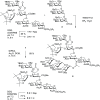Synthesis of an Undecasaccharide Featuring an Oligomannosidic Heptasaccharide and a Bacterial Kdo-lipid A Backbone for Eliciting Neutralizing Antibodies to Mammalian Oligomannose on the HIV-1 Envelope Spike
- PMID: 31010286
- PMCID: PMC6524000
- DOI: 10.1021/jacs.9b02872
Synthesis of an Undecasaccharide Featuring an Oligomannosidic Heptasaccharide and a Bacterial Kdo-lipid A Backbone for Eliciting Neutralizing Antibodies to Mammalian Oligomannose on the HIV-1 Envelope Spike
Abstract
Lipooligosaccharides (LOS) from the bacterium Rhizobium radiobacter Rv3 are structurally related to antigenic mammalian oligomannoses on the HIV-1 envelope glycoprotein spike that are targets for broadly neutralizing antibodies. Here, we prepared a hybrid structure of viral and bacterial epitopes as part of a vaccine design strategy to elicit oligomannose-specific HIV-neutralizing antibodies using glycoconjugates based on the Rv3 LOS structure. Starting from a Kdo2GlcNAc2 tetrasaccharide precursor, a central orthogonally protected mannose trichloroacetimidate donor was coupled to OH-5 of the innermost Kdo residue. To assemble larger glycans, the N-acetylamino groups of the glucosamine units were converted to imides to prevent formation of unwanted imidate byproducts. Blockwise coupling of the pentasaccharide acceptor with an α-(1→2)-linked mannotriosyl trichloroacetimidate donor introduced the D1-arm fragment. Glycosylation of O-6 of the central branching mannose with an α-(1→2)-α-(1→6)-linked mannotriosyl trichloroacetimidate donor unit then furnished the undecasaccharide harboring a D3-arm extension. Global deprotection yielded the 3-aminopropyl ligand, which was activated as an isothiocyanate or adipic acid succinimidoyl ester and conjugated to CRM197. However, representative oligomannose-specific HIV-neutralizing antibodies bound the undecasaccharide conjugates poorly. Possible reasons for this outcome are discussed herein along with paths for improvement.
Conflict of interest statement
The authors declare no competing financial interest.
Figures









Similar articles
-
Serum alpha-mannosidase as an additional barrier to eliciting oligomannose-specific HIV-1-neutralizing antibodies.Sci Rep. 2020 May 5;10(1):7582. doi: 10.1038/s41598-020-64500-8. Sci Rep. 2020. PMID: 32371950 Free PMC article.
-
Synthetic Neoglycoconjugates of Hepta- and Nonamannoside Ligands for Eliciting Oligomannose-Specific HIV-1-Neutralizing Antibodies.Chembiochem. 2022 Apr 5;23(7):e202200061. doi: 10.1002/cbic.202200061. Epub 2022 Feb 11. Chembiochem. 2022. PMID: 35104013 Free PMC article.
-
Comparative Antigenicity of Thiourea and Adipic Amide Linked Neoglycoconjugates Containing Modified Oligomannose Epitopes for the Carbohydrate-Specific anti-HIV Antibody 2G12.Bioconjug Chem. 2019 Jan 16;30(1):70-82. doi: 10.1021/acs.bioconjchem.8b00731. Epub 2018 Dec 28. Bioconjug Chem. 2019. PMID: 30525492 Free PMC article.
-
Structural Features of Broadly Neutralizing Antibodies and Rational Design of Vaccine.Adv Exp Med Biol. 2018;1075:73-95. doi: 10.1007/978-981-13-0484-2_4. Adv Exp Med Biol. 2018. PMID: 30030790 Review.
-
Env Exceptionalism: Why Are HIV-1 Env Glycoproteins Atypical Immunogens?Cell Host Microbe. 2020 Apr 8;27(4):507-518. doi: 10.1016/j.chom.2020.03.018. Cell Host Microbe. 2020. PMID: 32272076 Free PMC article. Review.
Cited by
-
Serum alpha-mannosidase as an additional barrier to eliciting oligomannose-specific HIV-1-neutralizing antibodies.Sci Rep. 2020 May 5;10(1):7582. doi: 10.1038/s41598-020-64500-8. Sci Rep. 2020. PMID: 32371950 Free PMC article.
-
A glycoside analog of mammalian oligomannose formulated with a TLR4-stimulating adjuvant elicits HIV-1 cross-reactive antibodies.Sci Rep. 2021 Feb 25;11(1):4637. doi: 10.1038/s41598-021-84116-w. Sci Rep. 2021. PMID: 33633304 Free PMC article.
-
The Impact of Sustained Immunization Regimens on the Antibody Response to Oligomannose Glycans.ACS Chem Biol. 2020 Mar 20;15(3):789-798. doi: 10.1021/acschembio.0c00053. Epub 2020 Mar 9. ACS Chem Biol. 2020. PMID: 32109354 Free PMC article.
-
Synthesis of Fungal Cell Wall Oligosaccharides and Their Ability to Trigger Plant Immune Responses.European J Org Chem. 2022 Jul 21;2022(27):e202200313. doi: 10.1002/ejoc.202200313. Epub 2022 Jul 15. European J Org Chem. 2022. PMID: 36035813 Free PMC article.
-
Exploratory N-Protecting Group Manipulation for the Total Synthesis of Zwitterionic Shigella sonnei Oligosaccharides.Chemistry. 2021 Mar 26;27(18):5694-5711. doi: 10.1002/chem.202003480. Epub 2021 Mar 1. Chemistry. 2021. PMID: 33314456 Free PMC article.
References
Publication types
MeSH terms
Substances
Grants and funding
LinkOut - more resources
Full Text Sources

